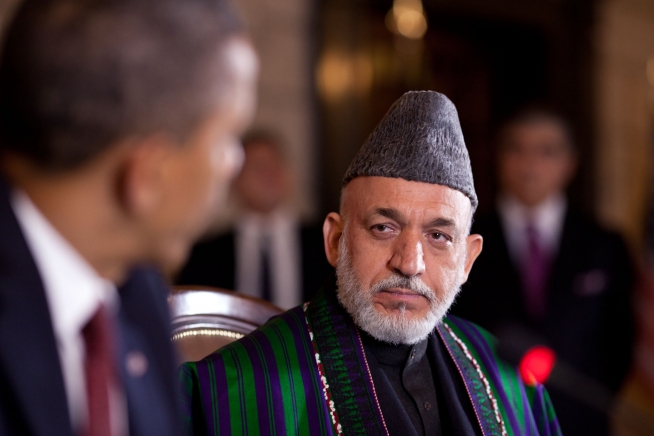Friday’s meeting between President Barack Obama and Afghan President Hamid Karzai was widely expected to produce an agreement on the pace of the US troop withdrawal and how many residual forces would remain after 2014, but neither was divulged in the press conference following their discussion in the White House except to vaguely say that the transition to Afghan rule would come quicker than expected.
 “Starting this spring our troops will have a different mission—training, advising and assisting Afghan forces,” Obama told reporters at the afternoon press conference, noting conspicuously the earlier-than-expected beginning of the transition while refusing to be specific about exact troop levels.
“Starting this spring our troops will have a different mission—training, advising and assisting Afghan forces,” Obama told reporters at the afternoon press conference, noting conspicuously the earlier-than-expected beginning of the transition while refusing to be specific about exact troop levels.
There are now 66,000 US troops in Afghanistan, down from about 100,000 at the height of the surge in 2011. The remaining are supposed to gradually withdraw by 2014, at which point a new status of forces agreement is to be signed governing the presence of US troops going forward.
The top US military general in Afghanistan, John Allen, has recommended keeping 6,000-20,000 US troops in country after the vaunted and wildly misrepresented 2014 “withdrawal.” Anonymous administration officials told Reuters Obama is quietly considering slightly less troops to stay beyond 2014, with numbers like 3,000-9,000 floating about and some even claimed a complete withdrawal is being considered, although it is extremely unlikely.
The fact that specific troop numbers, either during the transition or after 2014, was not talked about at all, is notable. President Obama said he was still receiving recommendations from the Pentagon on that score.
The two leaders articulated the usual vague rhetoric without much substance, especially Obama on the US’s supposedly limited mission of destroying and dismantling al-Qaeda and its affiliates.
But as Malou Innocent, a Foreign Policy Analyst at the Cato Institute has written, no amount of US troops in Afghanistan will put a dent in the actual threat of terrorist attacks.
 “[D]uring the protracted nation-building occupations of Iraq and Afghanistan, Americans still experienced the Times Square bomber, the underwear bomber, the Ft. Hood shooter, and other failed and foiled terrorist plots and near misses. In short, a residual U.S. presence of any size in Afghanistan ensures neither success nor failure against terrorism,” Innocent writes.
“[D]uring the protracted nation-building occupations of Iraq and Afghanistan, Americans still experienced the Times Square bomber, the underwear bomber, the Ft. Hood shooter, and other failed and foiled terrorist plots and near misses. In short, a residual U.S. presence of any size in Afghanistan ensures neither success nor failure against terrorism,” Innocent writes.
Indeed, US presence in Afghanistan, especially as its been used as a launching pad from which to bomb Pakistan with drones, directly contributed to the motivations of attackers like the Times Square bomber and the underwear bomber.
In his court statement, Faisal Shahzad, the so-called Times Square Bomber said he wanted to put a stop to “the drone strikes in Somalia and Yemen and in Pakistan and…the occupation of Muslim lands.” Killing American civilians in Times Square was justified, he said, because the drones, “they don’t see children, they don’t see anybody. They kill women, children, they kill everybody. It’s a war, and in war, they kill people. They’re killing all Muslims….I am part of the answer to the US terrorising the Muslim nations. I’m avenging the attacks…”
President Obama’s refusal to disclose any specific promises about drawing down US troops, and their presence after 2014, was troubling in that it seemed to acknowledge the war in Afghanistan is nowhere near over. But so long as any foreign occupation exists in Afghanistan, and so long as any corrupt Kabul government is propped up from abroad, the insurgency will remain alive and well.
More than a decade of military occupation and nation-building hasn’t managed to correct the problems of governance and tribal Islamic extremism in Afghanistan. Continuing the same policies won’t either.


